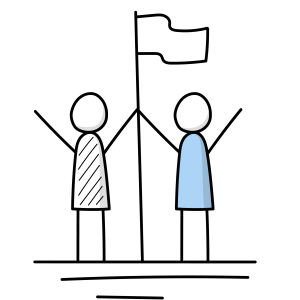RESEARCH ON ASSISTED SELF-HELP
With Assisted Self-Help, you can reach more people with anxiety and depression with effective help than with traditional talk therapy. This is shown by a randomized controlled trial (RCT) from the National Institute of Health (NHI) published in 2025.
Overall, the study supports Assisted Self-Help as part of the treatment offer at Rapid Mental Health Care. The treatment form is more accessible to users, requires significantly less therapist time and produces relatively good clinical results. This offer can therefore help reach more people struggling with anxiety and depression.


1. SATISFIED USERS
Assisted Self-Help users experienced the collaboration with the therapists as at least as satisfactory as with ordinary follow-up.
Users were generally satisfied with the treatment tool.
2. SIGNIFICANT IMPROVEMENT
The treatment resulted in significant improvement in symptoms of anxiety and depression. Six months after the start of treatment, the recovery rate was over 50 percent, which is in line with international standards.


3. NEARLY HALF TREATMENT TIME
Therapists spent about half as much time on treatment in the group receiving Assisted Self-Help compared to ordinary follow-up.
The estimated difference was 124.5 minutes per client, which is 1.8 times longer in ordinary follow-up than in Assisted Self-Help.
According to Marit Knapstad at the Norwegian Institute of Public Health, the time savings could help more people in need get help. This is useful because in many countries, including Norway, there is a large gap between the number of people with depression or anxiety and those who receive effective treatment.
OTHER RESEARCH
Rapid mental health care
Assisted Self-Help is used in a number of municipalities, and many of these offer the "Rapid Mental Health Help" model. NIPH has conducted a randomized controlled study, where Assistert Selvhjelp's tools were part of the offer. The study was conducted in Kristiansand Municipality and Sandnes Municipality, which have used Assistert Selvhjelp since 2016 and 2017 respectively. It explicitly points to increasing use of tools from Assistertselvhjelp.no in connection with data collection.
The study looked at the development of both anxiety and depression symptoms, as well as functioning and quality of life, and shows that of those who received treatment in Rapid Mental Health Care, nearly 60% could be considered healthy 6 months after the first assessment interview. No research has been done specifically on Assisted Self-Help. This is nevertheless in line with the fundamental idea that Assisted Self-Help does not change the treatment, only the “packaging”.
Digital processing
The tools that Assisted Self-Help offers are based on cognitive behavioral therapy (CBT), and are specifically aimed at anxiety, depression, and sleep disorders, for which internet-assisted treatment has been shown to have a good effect.
Internet-assisted therapy based on CAT has been shown to be effective treatment for anxiety and depression (and other conditions) in a number of studies.
Sources:
Cuijpers, P., Kleiboer, A., Karyotaki, E., & Riper, H. (2017). Internet and mobile
interventions for depression: Opportunities and challenges. Depression and Anxiety, 34(7), 596-
602.
doi:10.1002/da.22641
Haug, T., Nordgreen, T., Ost, LG, & Havik, OE (2012). Self-help treatment of anxiety
disorders: a meta-analysis and meta-regression of effects and potential moderators. Clinical
Psychology Review, 32(5), 425-445. doi:10.1016/j.cpr.2012.04.002
Olthuis, JV, Watt, MC, Bailey, K., Hayden, JA, & Stewart, SH (2016). Therapist-supported
Internet cognitive behavioral therapy for anxiety disorders in adults. Cochrane Database
Syst Rev, 3, Cd011565. doi:10.1002/14651858.CD011565.pub2
Little follow-up, big impact
The effect and the proportion who complete internet-assisted treatment also appear to increase with a minimum of follow-up during implementation.
The effect and degree of implementation can be achieved not only through follow-up by therapists trained in CAT, but also through a minimum of follow-up by other health personnel. This means that a large number of users can be treated with relatively few resources.
Sources: Apolinário-Hagen, J. (2019). Internet-Delivered Psychological Treatment Options for Panic
Disorder: A Review on Their Efficacy and Acceptability. Psychiatry Investigation, 16(1), 37-49.
doi:10.30773/pi.2018.06.26
Clark, D. M., Layard, R., Smithies, R., Richards, D. A., Suckling, R., & Wright, B. (2009).
Improving access to psychological therapy: Initial evaluation of two UK demonstration sites.
Behavior Research and Therapy, 47(11), 910-920. doi:10.1016/j.brat.2009.07.010

